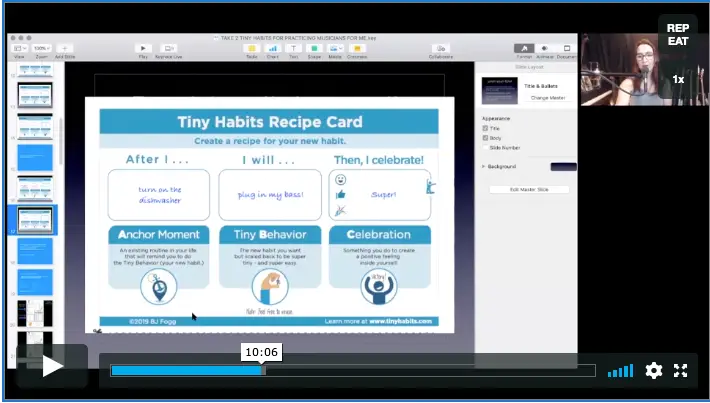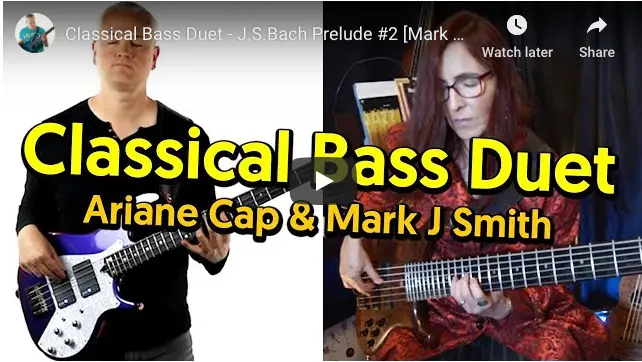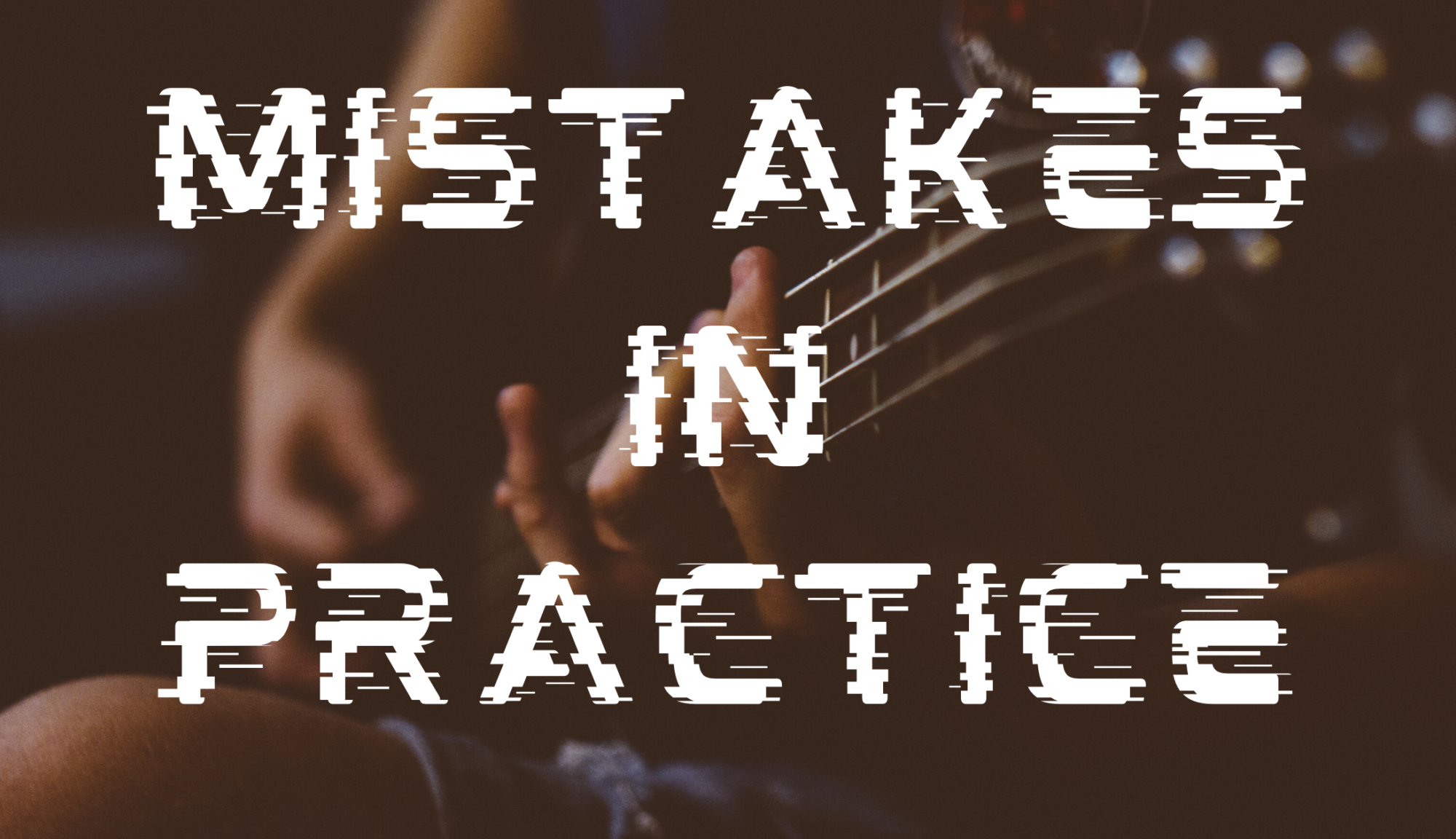One of our course participants just asked me this question.
Here is my answer: Neither!!
First let me say this loud and clear:
Never “go back to the top” if you made a mistake. Ever.
It is a terrible strategy. The reason why it’s a bad idea is that you will know the beginning quite well. Then get to the stumble, stumble and oops, “start over”. Somehow we think the error just didn’t happen and if we play it again it will magically resolve itself.
It won’t. In fact, chances are it will get worse and you will get frustrated..
“Starting over” each time is like procrastinating on fixing that dang error in bar 121 until you dread playing the piece so much you give up.
Try this instead.
I suggest a more methodical approach
I like to distinguish two different modes of practicing. One I call “Practice Mode” and the other, “Performance Mode“.
Both are useful as strategies for practicing.
First up: Practice Mode
Practice mode is up first because when you learn a new piece, that’s where you start.
In this mode, you:
- Figure out parts, notes, fingerings
- Use a pencil to take notes; circle rough spots; mark out fingerings, beats and articulation marks
- Work out intended phrasing, expression
- Listen to different versions of the song and take note (or notes!)
- Analyze the form, harmony, important aspects of the arrangement, transcribe important fills or you practice parts
- Do a lot of looping of sections; Go section by section, bit by bit
- Bring in the metronome or jam tracks, once you have a basic grasp of the song
And in this mode, if you run into a mistake you stop immediately…
And Ask yourself:
What happened? Was it a wrong note? Wrong rhythm?
I have had great success having my students verbalize what happened:
- What was the mistake: I played an Eb
- What should it have been: an E
- What led to the error: it’s a jump, hard to reach
- What’s the remedy? Maybe a different fingering. Maybe playing the E on a different string.
My suggested process once you figured out the remedy:
- Isolate that bar with the E (or the few notes in the passage that are difficult)
- Slow it down and loop it
- Then add a bar in front and a bar after
- Now loop that
- If it is a note error, go as slow as necessary until you are no longer making the mistake. If the error happens again, slow down the tempo even more (or eliminate the tempo entirely for the time being), isolate the jump
A different example:
- What happened? I turned the beat around. Dropped a quarter note.
- Which quarter note did I drop? [counting it out]: Beat 4.
The process once you figured out the issue:
- Leave out the pitches. Clap the rhythm of that bar only.
- Then play the rhythm of that bar on one note only. Count the rhythm until you start to feel it. The sensation is similar to thinking of a sentence that makes sense to you.
- Loop it until you feel it
- Then bring in the other pitches. Loop that.
- Then add a bar in front and a bar after
- Now loop that
That is the essence of what I call the Practice Mode. You are figuring out the right way, sleuthing for errors, tackling them head on (loop, loop, loop!). You dig deep for improvements on a granular level (individual notes, rhythm, technique, fingering, etc) and then embed what you practiced into the bigger picture (form, phrasing, dynamics).
Practice mode is all about hitting the brakes immediately when something unintended occurs and fixing it.
Now contrast that with: Performance Mode
Normally, we think of Performance Mode as the act of playing the song in front of an audience. When I speak of Performance Mode, it is also as part of a practice routine. In this mode, you practice the entire piece with the singular aim to get through to the end, no matter what happens – just as if you were on stage.
What you are practicing in this mode is to find your way back should a mistake happen. The goal is to stay with the flow of the music should a mistake occur. Or if you lose the form, to get comfortable finding your way back again. Things happen on the gig (regardless of “who’s fault” it was or what caused it) and we need to be flexible to keep going and find our way back. The song must go on!
You are also in Performance Mode when you play for your teacher or on the gig. In order to be comfortable, you need to have spent some time there.
In Performance Mode you aim to play the entire piece with focus and musical expression. If an error should happen, you move on without letting it throw you off the musical arc. Practice Performance Mode once you have played most parts flawlessly at least a few times in Practice Mode. No major fingering issues, no unclear transitions, or shaky spots. Occasional errors may still happen. Take note of them after you finished playing the piece. And if you make the same error twice, stop and go back to Practice Mode.
Bonus Tip:
Record Yourself
You will get the biggest bang for your practice buck by following the above recipe.
Once you find yourself ready for practicing “Performance Mode”, put up a camera (a simple iPhone is fine!) and record yourself. It will heighten your focus, and give you crystal clear feedback afterwards.
Possibly uncomfortable? Yes! – Beneficial and eye-opening? 1000% Yes!
In our Music Theory for the Bass Player Cohort Course students record themselves all the time and submit videos. Our coaches and the awesome vibe we have fostered there assures that these students feel supported submitting their “warts and all” videos. We recognize and appreciate that we are all in the same boat on a learning journey – nobody expects perfection. Without fail, everyone reports just how illuminating these videos are – from preparing for them to creating them, to – gasp – watching them, to posting them, and then reading the encouraging feedback. It really is quite something! It puts your practice “on steroids”!
To Sum it Up:
Never (repeat, never!) start over when you make a mistake. Stop and fix it using my Practice Mode strategies. When on the gig, keep going and make us forget it even happened because you are comfortable in Performance Mode.
Want more practical, applicable and unique tips for practicing and improving your playing? Sign up for our newsletter and you will never miss a blog post. As a bonus, receive three useful guides on how notes work!





 The “Become a Bassist” Summit
The “Become a Bassist” Summit
